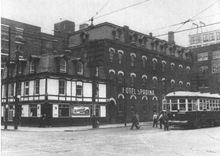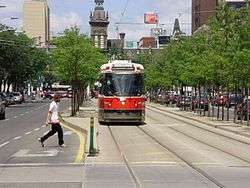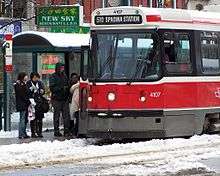510 Spadina
| 510 Spadina | |
|---|---|
|
Flexity Outlook streetcar southbound on Spadina Ave. south of Queen St. | |
| Overview | |
| Type | Streetcar Route |
| Locale | Toronto, Ontario |
| Termini |
Spadina Station (North) Union Station (South) |
| Stations |
|
| Operation | |
| Operator(s) | Toronto Transit Commission |
| Depot(s) | Leslie Barns |
| Rolling stock | Flexity Outlook |
| Technical | |
| Line length | 6.165 km (3.83 mi) [1] |
| Track gauge | 4 ft 10 7⁄8 in (1,495 mm) - TTC Gauge |
| Electrification | 600 VDC Overhead |
| Route number | 510 |
510 Spadina (317 Spadina during overnight periods) is a streetcar route in Toronto, Ontario, Canada, operated by the Toronto Transit Commission.
History

Spadina's streetcar service began in 1891, when a loop route called the Belt Line operated on Bloor Street, Spadina Avenue, Sherbourne Street, and King Street.[2] In a 1923 reconfiguration of the streetcar network, this service was discontinued and Spadina became a separate streetcar route. This route was operated until 1948, when it was replaced by buses.[3] The tracks on Spadina between Dundas Street and Harbord Street were used by the Harbord streetcar route until its discontinuation in 1966.[3]

The modern 510 Spadina route began as the 604 Harbourfront LRT route along Queens Quay in 1990, using CLRV and ALRV streetcars. The route was later renamed the 510 Harbourfront. It became the 510 Spadina and replaced the 77 Spadina bus when a new dedicated right-of-way was opened in 1997. The right-of-way extended the track north along Spadina Avenue from Queens Quay to Spadina station on the Bloor subway line.
The term "light-rail transit" (LRT), which had been adopted to project an image of modernity, was dropped when it led to residents and newspaper reporters imagining elevated guideways like those of the Scarborough RT running through their streets. It was found that the project was much easier to sell to the public and politicians when it was described as an improvement to the speed and reliability of traditional streetcar service.
In 2000, when the Queens Quay streetcar tracks were extended west to Bathurst and Fleet Streets, the name Harbourfront reappeared for a 509 Harbourfront route between Union and Exhibition Loop. The 509 and 510 routes share the trackage that had been used by the 604.

In 2005, The Globe and Mail newspaper published an article that criticized the switch to a dedicated right-of-way streetcar as being less beneficial than promised. Based on TTC documents, the author argued that service is about one minute slower (from Queens Quay to Bloor) during afternoon rush hour than in 1990. The author also cited TTC documents which show that the cost-to-revenue ratio of the route has fallen with the switch from buses to streetcars.[4] Mitch Stambler, the TTC’s manager of service planning, responded by pointing out that streetcars offer a smoother and quieter ride, zero emissions, and economic development.[4]
Ridership increased from 26,000 per day on the 77 bus route to 35,000 per day on the Spadina streetcar in 2004 and to over 45,000 per day in 2005-2006.[5] Streetcars on the Spadina portion run every 2–3 minutes every day.
On December 15, 2008, the next vehicle arrival notification system was installed for the 510 streetcar in the Spadina and Union subway stations. The next vehicle arrival notification system includes a display screen that shows the location of the streetcars in "real" time with a delay of one minute.[6]
On June 18, 2012, all streetcar service on the line was suspended and replaced by buses.[7] This was to allow major track work to be completed in preparation for the TTC's new low-floor Bombardier Transportation custom-made Flexity Outlook streetcars which were scheduled to enter service on the Spadina line in 2014.[8] The upgrades were completed and full streetcar service was restored two years later on August 31, 2014, including a ceremony at 10:00 am when the first two accessible low-floor Flexity vehicles officially entered revenue service.[9] Coinciding with the launch of the new vehicles, the 510 Spadina became the first full-time Proof-of-payment (POP) line which allows passengers with POP - such as a valid TTC pass, transfer or Presto card - to board at any door of the streetcar. This is because in the new Flexity streetcars, the operator is situated inside a fully closed booth and is not responsible for fare collection or providing paper POP transfers.[10]
On September 6, 2015, after a 13-year absence, the TTC reinstated its overnight service on this route. The night service was designated as 317 Spadina, and was part of the expanded Blue Night Network streetcar services resulting from a $95 million investment from Toronto City Council. During overnight periods, streetcars operate approximately every 30 minutes. The TTC had operated an overnight service using buses on Spadina from 1987 until 1992 when it was discontinued due to a series of cutbacks in TTC service.
Route
| 510 Spadina | ||||||||||||||||||||||||||||||||||||||||||||||||||||||||||||||||||||||||||||||||||||||||||||||||||||||||||||||||||||||||||||||||||||||||||||||||||||||||||||||||||||||||||||||||||||||||||||||||||||||||||||||||||
|---|---|---|---|---|---|---|---|---|---|---|---|---|---|---|---|---|---|---|---|---|---|---|---|---|---|---|---|---|---|---|---|---|---|---|---|---|---|---|---|---|---|---|---|---|---|---|---|---|---|---|---|---|---|---|---|---|---|---|---|---|---|---|---|---|---|---|---|---|---|---|---|---|---|---|---|---|---|---|---|---|---|---|---|---|---|---|---|---|---|---|---|---|---|---|---|---|---|---|---|---|---|---|---|---|---|---|---|---|---|---|---|---|---|---|---|---|---|---|---|---|---|---|---|---|---|---|---|---|---|---|---|---|---|---|---|---|---|---|---|---|---|---|---|---|---|---|---|---|---|---|---|---|---|---|---|---|---|---|---|---|---|---|---|---|---|---|---|---|---|---|---|---|---|---|---|---|---|---|---|---|---|---|---|---|---|---|---|---|---|---|---|---|---|---|---|---|---|---|---|---|---|---|---|---|---|---|---|---|---|---|
Legend | ||||||||||||||||||||||||||||||||||||||||||||||||||||||||||||||||||||||||||||||||||||||||||||||||||||||||||||||||||||||||||||||||||||||||||||||||||||||||||||||||||||||||||||||||||||||||||||||||||||||||||||||||||
| ||||||||||||||||||||||||||||||||||||||||||||||||||||||||||||||||||||||||||||||||||||||||||||||||||||||||||||||||||||||||||||||||||||||||||||||||||||||||||||||||||||||||||||||||||||||||||||||||||||||||||||||||||
510 streetcars are operated in their own right-of-way (ROW), except for the one-way short turn loop at Spadina Avenue and King Street, via Adelaide Street West and Charlotte Street. There are no plans to institute a right-of-way here as it would not benefit operation significantly.
Most stops along the routes are surface stops with islands separating the regular traffic from the streetcar tracks, and have streetcar traffic signals, partial shelters, and railings to protect patrons from the traffic.
Streetcars enter underground subway stations at Union and Spadina TTC stations, and a dedicated underground streetcar station at Queens Quay. Except late at night, every other or two of three streetcars operate only between Spadina subway station and King Street, the busiest portion of the route.
Route branches
- 510 Spadina to Union Station/510 Spadina to Spadina Station: Spadina to Union via Queens Quay
- 510 Spadina to King: Southbound from Spadina to Spadina Ave and King St.
- 510 Spadina to Queens Quay and Spadina: Southbound from Spadina to Queens Quay and Spadina Loop
Points of interest
| Location | Stops |
|---|---|
| University of Toronto | Sussex Avenue – College Street |
| Kensington Market | College Street – Dundas Street |
| George Brown College | Dundas Street |
| Chinatown | College Street – Queen Street |
| Fashion District | Queen Street – Bremner Boulevard |
| Rogers Centre | Lower Spadina Avenue – Simcoe Street |
| CN Tower | Lower Simcoe Street |
| Queen's Quay Terminal | York Street, Queen's Quay Station |
| Harbourfront Centre Islands ferry docks | Queens Quay Station |
Stops
Stops along 510 consist of a raised concrete platform with a partially covered shelter and railings along the entire boarding area. Platforms are located on the far-side of most intersections, to make room for left-turn lanes on the near side. TTC streetcars are equipped with a Surface Vehicle Automatic Stop Announcement System (SVASAS) which calls out the stops through the public address system and on the LED board.
See also
References
- ↑ Toronto Transit Commission (September 18, 2009). "TTC Service Summary" (PDF).
- ↑ Mike Filey (2003). "Toronto Sketches 7: The Way We Were". Dundurn Publishing. pp. 19–21. ISBN 9781550024487. Retrieved 16 November 2012.
- 1 2 John F. Bromley and Jack May (1973). 50 Years of Progressive Transit. Electric Railroaders' Association. pp. 37, 74, 107, and map section.
- 1 2 Stephen Wickens (May 7, 2005). "RAPID TRANSIT? NOT ON SPADINA Summary".
- ↑ http://www.lightrailnow.org/news/n_newslog001.htm, http://www.toronto.ca/ttc/pdf/ridership_cost_stats_bus_streetcar_05_06.pdf
- ↑ TTC launches next vehicle arrival notification pilot project
- ↑ Mackenzie, Robert (13 June 2012). ""Get on the bus, the Spadina bus"...". Transit Toronto. Retrieved 4 March 2016.
- ↑ Kalinowski, Tess (18 June 2013). "TTC announces Spadina as first line for new streetcars". Thestar.com. Toronto Star. Torstar. Retrieved 4 March 2015.
- ↑ Munro, Steve (5 September 2014). "Flexities Debut on Spadina". Transit & Politics. WordPress. Retrieved 9 April 2015.
- ↑ "Proof-of-Payment (POP)". Fares & Passes. Toronto Transit Commission. Retrieved 17 March 2015.
- ↑ "510 Spadina: Route Description". Toronto Transit Commission. Retrieved 2009-10-06.
External links
| Wikimedia Commons has media related to 510 Spadina. |
- Trains and Streetcars
- Route 510 - Spadina Streetcar (Transit Toronto)
- Light Rail Now! Newslog
_(14918534190).jpg)
